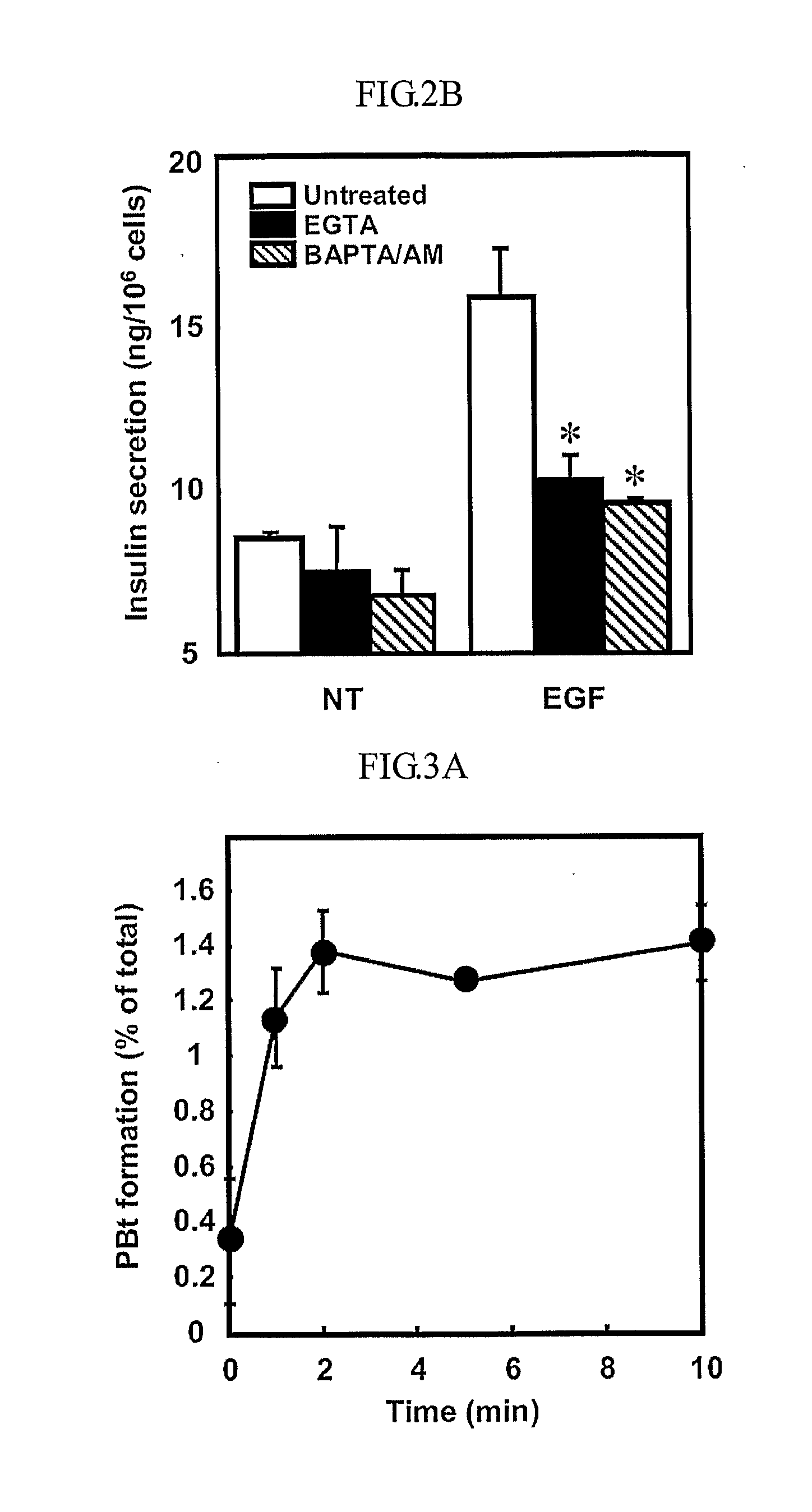Epidermal growth factor increasing insulin secretion and lowering blood glucose
a growth factor and insulin secretion technology, applied in the direction of drug compositions, peptide/protein ingredients, metabolic disorders, etc., can solve the problems that the role of egf in glucose regulation by modulating pancreatic function such as insulin secretion has not been studied, and achieve the effect of lowering plasma glucose levels and egf treatmen
- Summary
- Abstract
- Description
- Claims
- Application Information
AI Technical Summary
Benefits of technology
Problems solved by technology
Method used
Image
Examples
example 1
EGF Stimulates Insulin Secretion in MIN6 Cells
[0037]EGF is produced in the pancreas, has pancreatic effects, and its circulating levels are altered in diabetes (Burgess A W, Br Med Bull 45:401-424, 1989; Kasayama S et al., Proc Natl Acad Sci USA 86:7644-7648, 1989). This example was performed to determine whether EGF could stimulate insulin secretion, and whether insulin secretion by EGF was additive by glucose treatment.
[0038]1.1 Method
[0039]Cell Culture The mouse insulin-producing cells MIN6m9 provided by Dr. Susumu Seino (Division of Cellular and Molecular Medicine, Kobe University Graduate School of Medicine, Kobe, Japan) were used between passages 19 and 25 and cultured in DMEM containing 25 mM glucose, 10 mM HEPES, 10% (v / v) fetal calf serum, 50 IU / ml penicillin, and 50 μg / ml streptomycin at 37° C. in a humidified CO2-controlled (5%) incubator. MIN6 cells were transfected using LipofectAMINE, as described previously (Kim et al., J Immunol 163:5462-5470, 1999) Transfection effi...
example 2
EGF-Induced Insulin Secretion is Dependent on Ca2+ Influx in MIN6 Cells
[0050]Insulin secretion requires increases in intracellular Ca2+ concentrations ([Ca2+]i) (Barg S et al., Diabetes 51 (Suppl 1):S74-82, 2002). This example was carried out to determine the effect of Ca2+ influx on EGF-induced insulin secretion.
[0051]2.1 [Ca2+]i Measurement Method
[0052]Changes in intracellular Ca2+ levels were monitored using a Ca2+-sensitive dye under a confocal microscope. Cells were loaded with 2 μl Fluo-3 AM for 40 min at room temperature. After washing with Krebs-Ringer bicarbonate (KRB; 129 mM NaCl, 5 mM NaHCO3, 4.8 mM KCl, 1.2 mM KH2PO4, 1.0 mM CaCl2, 1.2 mM MgSO4, 2.7 mM glucose, and 10 mM HEPES, pH 7.4) buffer, the cells were further incubated for 15 min in the absence of Fluo-3 AM to de-esterify the dye. To exclude the possible effects of dye loading, the present inventors normalized levels with saponin at the end of the experiments. To normalize, the present inventors measured the resid...
example 3
PLD2 Mediates EGF-Dependent Insulin Secretion in MIN6 Cells
[0059]Previous reports suggested that PLD is an important molecule that mediates various exocytosis (Jones D et al., Biochim Biophys Acta 1439:229-244, 1999; Choi W S et al., J Immunol 168:5682-5689, 2002; Metz S A et al., Biochem J 270:427-435, 1990). The present inventors firstly tested the PLD activity in MIN6 cells. PLD was activated rapidly (within 2 min) by EGF stimulation (FIG. 3A). EGF-dependent insulin secretion was inhibited by 1-butanol, a PLD inhibitor, treatment, but not by t-butanol treatment as a control (FIG. 3B). These results suggest that PLD activity is necessary for EGF-induced insulin secretion. The same results were also observed in RINm5F cells (data not shown).
[0060]PLD Constructs: The full-length cDNAs of rat PLD1 or human PLD2 were ligated into pcDNA 3.1 vector for transfecting into cells.
[0061]SiRNA Sequences: The siRNA of 21-mers corresponding to mouse PLD1 (nucleotides 1099 to 1119, AACACGUUAGCUA...
PUM
| Property | Measurement | Unit |
|---|---|---|
| body weight | aaaaa | aaaaa |
| body weight | aaaaa | aaaaa |
| body weight | aaaaa | aaaaa |
Abstract
Description
Claims
Application Information
 Login to View More
Login to View More - R&D
- Intellectual Property
- Life Sciences
- Materials
- Tech Scout
- Unparalleled Data Quality
- Higher Quality Content
- 60% Fewer Hallucinations
Browse by: Latest US Patents, China's latest patents, Technical Efficacy Thesaurus, Application Domain, Technology Topic, Popular Technical Reports.
© 2025 PatSnap. All rights reserved.Legal|Privacy policy|Modern Slavery Act Transparency Statement|Sitemap|About US| Contact US: help@patsnap.com



